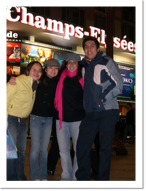
This afternoon, we went to an exhibition of four early twentieth-century Viennese painters at the Grand Palais: Kokoschka, Moser, Klimt, and Schiele. We took an hour to walk through the exhibit, unguided this time. I could tell before we even entered that the exhibit would be crowded, but I can hardly describe the throngs of Parisians and foreigners who were inside. It was possibly the most crowded exhibition I have ever been to! Obviously, the French love art.

Among the four painters, I preferred the works of Oskar Kokoschka the most, notably  “Couple d’amants (nus)” (1913) and “Portrait de Bertha Eckstein-Diener” (1910). Kokoschka’s figures had pensive faces and the colors were in pastels, unlike the harsher reds and blacks of other works I have seen over the past 2 weeks. I also liked one of the paintings by Kolomar Moser, “Trois femmes accroupies” (1914). The style, overall, of these four men differs from both the contemporary artists of the Centre Pompidou and the Impressionist painters of the Musée d’Orsay. Here, much emphasis was placed on the positioning of the figures and on frontal format. Also, many paintings featured nudes, one common characteristic for European painters, I have concluded. The French are very comfortable with displaying publicly the human body, unlike Americans, and do not hesitate to feature it in art, clothing styles, and advertisements.
“Couple d’amants (nus)” (1913) and “Portrait de Bertha Eckstein-Diener” (1910). Kokoschka’s figures had pensive faces and the colors were in pastels, unlike the harsher reds and blacks of other works I have seen over the past 2 weeks. I also liked one of the paintings by Kolomar Moser, “Trois femmes accroupies” (1914). The style, overall, of these four men differs from both the contemporary artists of the Centre Pompidou and the Impressionist painters of the Musée d’Orsay. Here, much emphasis was placed on the positioning of the figures and on frontal format. Also, many paintings featured nudes, one common characteristic for European painters, I have concluded. The French are very comfortable with displaying publicly the human body, unlike Americans, and do not hesitate to feature it in art, clothing styles, and advertisements.
 “Couple d’amants (nus)” (1913) and “Portrait de Bertha Eckstein-Diener” (1910). Kokoschka’s figures had pensive faces and the colors were in pastels, unlike the harsher reds and blacks of other works I have seen over the past 2 weeks. I also liked one of the paintings by Kolomar Moser, “Trois femmes accroupies” (1914). The style, overall, of these four men differs from both the contemporary artists of the Centre Pompidou and the Impressionist painters of the Musée d’Orsay. Here, much emphasis was placed on the positioning of the figures and on frontal format. Also, many paintings featured nudes, one common characteristic for European painters, I have concluded. The French are very comfortable with displaying publicly the human body, unlike Americans, and do not hesitate to feature it in art, clothing styles, and advertisements.
“Couple d’amants (nus)” (1913) and “Portrait de Bertha Eckstein-Diener” (1910). Kokoschka’s figures had pensive faces and the colors were in pastels, unlike the harsher reds and blacks of other works I have seen over the past 2 weeks. I also liked one of the paintings by Kolomar Moser, “Trois femmes accroupies” (1914). The style, overall, of these four men differs from both the contemporary artists of the Centre Pompidou and the Impressionist painters of the Musée d’Orsay. Here, much emphasis was placed on the positioning of the figures and on frontal format. Also, many paintings featured nudes, one common characteristic for European painters, I have concluded. The French are very comfortable with displaying publicly the human body, unlike Americans, and do not hesitate to feature it in art, clothing styles, and advertisements.In Paris, I feel very immersed in French artistic cultural awareness. The high attendance at all the museums we have visited and the abundance of museums spanning many types of art make it easy to sample the entire spectrum of French and European art.


January 16, 2006
An Exhibition of Four Viennese Painters




